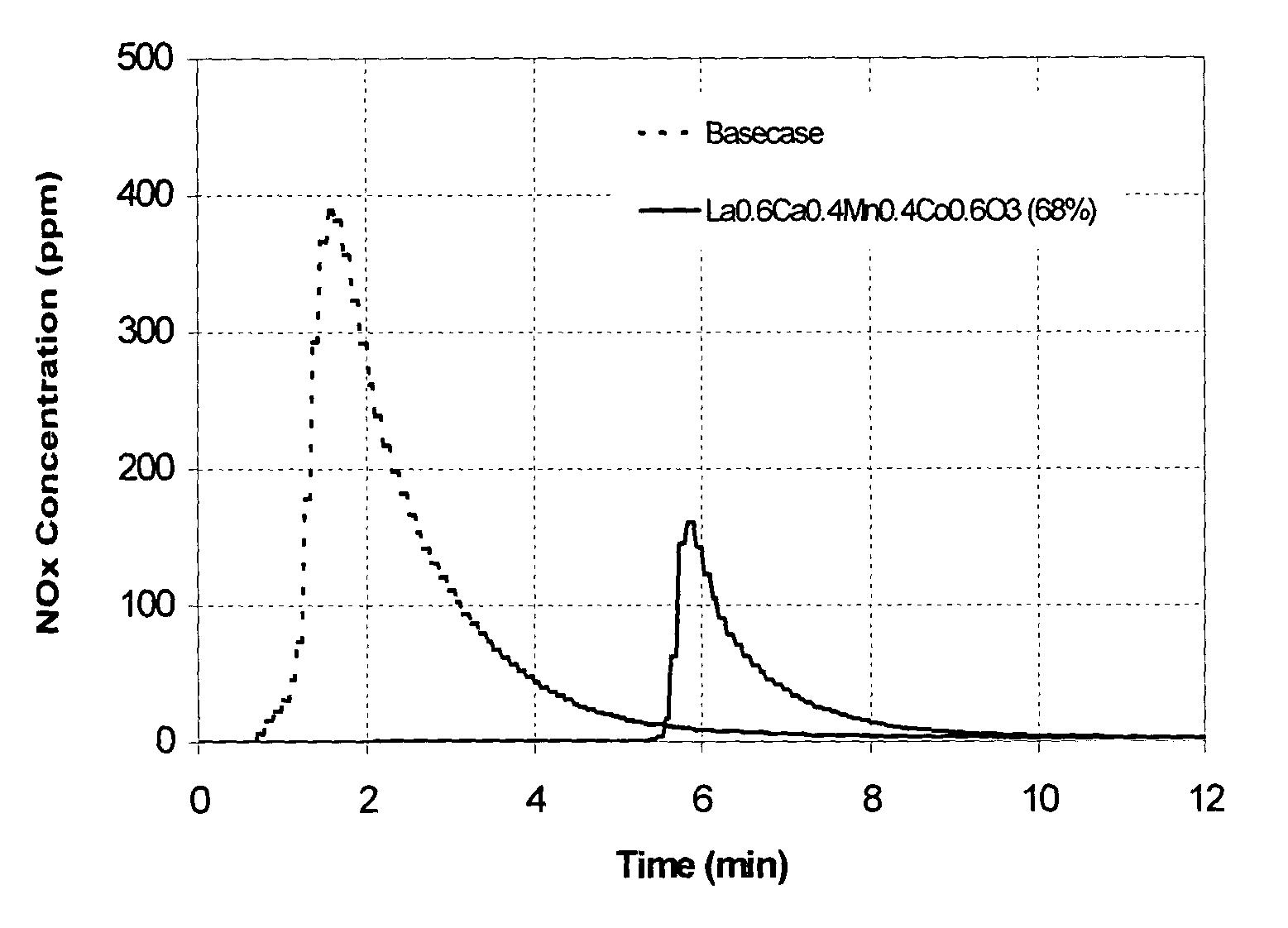Combined cracking and selective hydrogen combustion for catalytic cracking
a technology of hydrogen combustion and catalytic cracking, which is applied in the direction of catalyst activation/preparation, metal/metal-oxide/metal-hydroxide catalyst, combustion gas purification/modification, etc., can solve the problems of high cost of steam cracking, complex technology, and unsuitable steam cracking,
- Summary
- Abstract
- Description
- Claims
- Application Information
AI Technical Summary
Problems solved by technology
Method used
Image
Examples
example 2
[0170] This example illustrates the preparation and performance of selective hydrogen combustion (SHC) catalyst for reducing the hydrogen yield in the product, while minimizing non-selective hydrocarbon oxidation. La.sub.aMn.sub.bNi.sub.cAl.sub.dO.sub.x catalyst was prepared by co-precipitation of metal salts using an organic base and a carbonate precursor. Solution A was prepared by dissolving 9.106 grams of lanthanum nitrate hexahydrate (Aldrich Chemical Company, Milwaukee, Wis.), 1.059 grams of manganese (II) chloride (Aldrich Chemical Company, Milwaukee, Wis.), 2.446 grams of nickel nitrate hexahydrate (Aldrich Chemical Company, Milwaukee, Wis.), and 1.578 grams of aluminum nitrate nonahydrate (Aldrich Chemical Company, Milwaukee, Wis.) in 210 grams of deionized water. Solution B was prepared by dissolving 13.3 grams of sodium bicarbonate (Mallinckrodt Baker Inc., Paris, Ky.) and 39.8 grams of tetraethylammonium hydroxide, 35 wt % solution (Alfa Aesar, Ward Hill, Mass.) in 631 g...
example 3
[0173] This example illustrates the preparation and performance of selective hydrogen combustion (SHC) catalyst for reducing the hydrogen yield in the product, while minimizing non-selective hydrocarbon oxidation. Sc.sub.aCu.sub.bMn.sub.cO.sub.x catalyst was prepared by co-precipitation of metal salts using an organic base in an alcohol medium. Solution A was prepared by dissolving 3.642 grams of scandium nitrate hydrate (Alfa Aesar, Ward Hill, Mass.), 0.323 grams of copper (II) nitrate hydrate (Alfa Aesar, Ward Hill, Mass.), 1.681 grams of manganese (II) chloride (Aldrich Chemical Company, Milwaukee, Wis.) in 67 grams of deionized water. Solution B was prepared by dissolving 58 grams of tetraethylammonium hydroxide, 35 wt % solution (Alfa Aesar, Ward Hill, Mass.) in 225 grams of isopropanol (VWR Scientific Products Corporation, Chicago, Ill.). Solution A was slowly poured into a well-stirred solution B, resulting in precipitate formation. After aging the suspension for 1 hour, the ...
example 4
[0176] Table 3 shows the performance of additional combinations of sub-group 1 SHC catalysts with the cracking catalyst of Example 1. All tests were run at the conditions described in Example 1 with 0.5 grams of the SHC catalyst being tested mixed with 2.0 grams of SiC and either 1.0 grams of steamed OlefinsMax or 0.5 grams of fresh OlefinsMax.
3 TABLE 3 Catalyst Composition % H.sub.2 Conversion % H.sub.2 Selectivity Y.sub.0.2In.sub.0.6Zn.sub.0.2MnO.sub.3 84.2 100 LaMn.sub.0.4Ni.sub.0.4Al.sub.0.2O.sub.3 69.1 91 La.sub.0.9Mn.sub.0.8Al.sub.0.2O.sub.3 41.4 100 Sc.sub.0.9Cu.sub.0.1MnO.sub.3 53.8 55 Sc.sub.0.8Zn.sub.0.2MnO.sub-.3 55.6 34 Zr.sub.0.6La.sub.0.4O.sub.2 10.7 100 La.sub.0.05--Zr.sub.0.95O.sub.2 11.6 90 Mn.sub.0.9Sc.sub.0.1O.sub-.2 15.0 27 Pr.sub.0.7In.sub.0.2Zn.sub.0.1O.sub.2 14.3 20
Examples Comprising Metals from Sub-Group 2
PUM
| Property | Measurement | Unit |
|---|---|---|
| Fraction | aaaaa | aaaaa |
| Fraction | aaaaa | aaaaa |
| Pressure | aaaaa | aaaaa |
Abstract
Description
Claims
Application Information
 Login to View More
Login to View More - R&D
- Intellectual Property
- Life Sciences
- Materials
- Tech Scout
- Unparalleled Data Quality
- Higher Quality Content
- 60% Fewer Hallucinations
Browse by: Latest US Patents, China's latest patents, Technical Efficacy Thesaurus, Application Domain, Technology Topic, Popular Technical Reports.
© 2025 PatSnap. All rights reserved.Legal|Privacy policy|Modern Slavery Act Transparency Statement|Sitemap|About US| Contact US: help@patsnap.com

